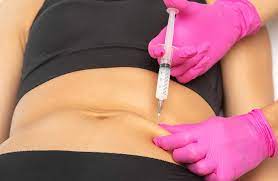Say goodbye to stubborn fat with fat lipolysis

Are you tired of struggling with stubborn fat that just won't budge, no matter how hard you hit the gym or stick to a strict diet? You're not alone. Many people struggle with pockets of fat that seem resistant to traditional weight loss methods. Fortunately, there is a solution: fat lipolysis.
Fat lipolysis is a non-invasive treatment that targets specific areas of fat and uses various methods, such as laser energy, injections, or ultrasound, to break down fat cells in the adipose tissue. The result? A slimmer, more contoured you.
If you're looking to boost your body confidence and achieve your desired figure, fat lipolysis may be the solution you've been looking for. Read on to learn more about this innovative treatment and how it can help you say goodbye to stubborn fat for good.
Understanding fat lipolysis
Fat lipolysis is a non-surgical procedure that helps to break down and remove adipose tissue or stubborn fat from specific areas of the body. This treatment is effective for those who are unable to eliminate resistant fat through diet and exercise alone.
The process of fat lipolysis involves various techniques, such as laser energy, injection, or ultrasound, to destroy the fat cells in the adipose tissue. These methods create a controlled injury within the fat cells, which causes them to break down and be naturally eliminated from the body.
How fat lipolysis works
Laser energy, for example, is applied to the targeted area using a laser device. The heat generated from the laser causes the fat cells to rupture and release their contents, which are then eliminated naturally from the body. Injection therapy involves injecting a solution into the subcutaneous tissue that breaks down the fat cells. Similarly, ultrasound therapy uses high-frequency sound waves to disrupt the fat cells, causing them to break down and be eliminated naturally.
Fat lipolysis is a minimally invasive treatment that is typically performed on an outpatient basis, allowing patients to return to their normal activities within a short period of time. However, the number of treatment sessions required varies depending on the size of the targeted area and the desired results.
Overall, fat lipolysis is a safe and effective method for removing stubborn fat and achieving a slimmer, more contoured body shape.
Benefits of fat lipolysis
Fat lipolysis offers many benefits for individuals looking to contour their body without surgery or downtime. This non-invasive treatment can target specific areas of stubborn fat and provide noticeable results.
One of the main advantages of fat lipolysis is its ability to produce a slimmer body shape. By removing unwanted fat cells, the treatment can help individuals achieve their desired body contouring goals.
Compared to other fat reduction methods, such as liposuction or coolsculpting, fat lipolysis is a less invasive option that involves little to no recovery time. This means that individuals can resume their regular activities shortly after the treatment.
Another benefit of fat lipolysis is that it is a targeted approach to fat reduction. This means that it can be used to address specific areas of the body, such as the abdomen, thighs, or arms, where stubborn fat is often more difficult to lose through exercise and diet alone.
Overall, fat lipolysis is a safe and effective treatment for individuals looking to achieve a slimmer body shape without undergoing surgery. By targeting specific areas of fat and producing noticeable results, fat lipolysis can help boost body confidence and provide a more positive self-image.
Who is a suitable candidate for fat lipolysis?
Fat lipolysis is a non-invasive treatment that can help individuals achieve a slimmer body by targeting stubborn fat. While it is a safe and effective procedure for many people, there are specific criteria that must be met in order to be a suitable candidate.
Body weight and BMI are important considerations when determining if someone is a suitable candidate for fat lipolysis. The treatment is designed for individuals who are already close to their ideal body weight and have a BMI of 30 or less.
It is also essential to consult with a qualified professional before undergoing fat lipolysis. They can assess your individual situation and determine if the procedure is appropriate for you. There may be potential contraindications, such as certain medical conditions or medications, that need to be taken into account.
The Fat Lipolysis Process
The fat lipolysis process typically involves several treatment sessions, depending on the individual's specific needs and desired results. During each session, a qualified professional will use a targeted approach to break down fat cells in the adipose tissue.
There are various methods of fat lipolysis, including laser energy, injection, or ultrasound. The chosen method will depend on the individual's unique circumstances and desired outcome.
The treatment itself is non-invasive, meaning there is no surgery or downtime required. Most individuals are able to resume their normal daily activities immediately following the procedure.
The Procedure
During the procedure, the targeted area of the body will be marked and a local anesthetic may be applied to reduce discomfort. The chosen method of fat lipolysis will then be used to break down the fat cells in the targeted area.
Depending on the method used, the individual may experience some temporary discomfort, bruising, or swelling in the treated area. However, these side effects are typically mild and will subside within a few days.
Number of Sessions and Recovery
The number of treatment sessions required will vary depending on the individual's goals and the amount of fat being targeted. Most individuals will require several sessions to achieve their desired results.
Post-treatment recovery is generally minimal, with most individuals experiencing little to no downtime. However, it is important to follow any aftercare instructions provided by the treating professional, including avoiding strenuous physical activity for a short period after treatment.
Safety and side effects of fat lipolysis
Fat lipolysis is generally considered to be a safe and effective treatment for removing stubborn fat without surgery. However, as with any medical procedure, there are potential risks and side effects to consider.
Some of the most commonly reported side effects of fat lipolysis include temporary discomfort, swelling, bruising, and redness in the treated area. These symptoms typically subside within a few days following treatment.
In rare cases, more serious side effects such as infection, scarring, or changes in skin sensation may occur. To minimize the risk of these complications, it is important to choose a qualified and experienced medical professional who can properly assess your suitability for the treatment and perform it safely.
If you experience any concerning symptoms following fat lipolysis treatment, such as fever, severe pain, or abnormal skin changes, it is important to contact your healthcare provider immediately.
Overall, fat lipolysis is considered to be a safe and effective treatment for body contouring. However, it is important to discuss any concerns or potential risks with your healthcare provider before undergoing the procedure.
Maintaining results after fat lipolysis
After undergoing fat lipolysis, it is important to maintain a healthy lifestyle and continue exercising regularly to ensure long-term results. While fat cells do not regenerate, the remaining cells can expand if a person gains weight, potentially reversing the effects of the treatment.
To maximize the benefits of fat lipolysis, patients should maintain a balanced diet that is rich in fruits, vegetables, and lean protein. Avoid processed foods, sugary drinks and snacks, and excessive amounts of alcohol. Drinking plenty of water and getting enough sleep are also essential for maintaining a healthy weight and overall well-being.
Regular exercise can help to burn calories and build lean muscle, which can help to boost metabolism and maintain a healthy weight. Aim for at least 30 minutes of moderate exercise most days of the week, such as brisk walking, cycling, or swimming. Incorporating strength-training exercises, such as weightlifting or bodyweight exercises, can help to build muscle and tone the body.
It is also important to practice self-care and manage stress to ensure optimal health and well-being. This can include engaging in relaxing activities, such as yoga or meditation, spending time in nature, or getting a massage. Taking care of your mental health is just as important as your physical health, so be sure to prioritize both.
Comparing fat lipolysis to other fat reduction methods
While there are several options for fat reduction, fat lipolysis stands out as a non-invasive, safe, and effective treatment. It has a number of advantages over other methods, including:
| Method | Advantages | Disadvantages |
|---|---|---|
| Liposuction | - Can remove large amounts of fat | - Requires anesthesia and incisions - Longer recovery time - Possible complications |
| CoolSculpting | - Non-invasive | - Limited to certain areas of the body - May require multiple treatments - Results may take longer to appear |
Fat lipolysis, on the other hand, can target specific areas of fat without incisions or anesthesia. It is a quick and easy treatment that typically requires no downtime. Plus, it can achieve noticeable results after just a few sessions.
While liposuction may be ideal for those looking to remove larger amounts of fat, it comes with a greater risk of complications and a longer recovery time. CoolSculpting may be a good option for those seeking a non-invasive treatment, but it may not be able to target as many areas as fat lipolysis and may require multiple treatments.
Overall, fat lipolysis is a versatile and effective fat reduction method that can provide significant results without surgery or downtime.
Success stories and testimonials
Many individuals have achieved impressive results with fat lipolysis, successfully eliminating stubborn fat and achieving a slimmer body. Here are some of their stories:
"I struggled with stubborn fat in my abdomen area for years, despite trying various diets and exercise routines. I finally decided to try fat lipolysis and couldn't be happier with the results. After just a few sessions, I noticed a significant reduction in my belly fat, and my clothes fit so much better." - Sarah
In addition to Sarah's success, many others have reported similar outcomes.
| Name | Location | Results |
|---|---|---|
| Jessica | Los Angeles, CA | Lost 3 inches off waistline |
| Mike | New York, NY | Eliminated love handles |
| Amy | Miami, FL | Overall body contouring |
These success stories demonstrate the effectiveness of fat lipolysis in contouring the body and eliminating stubborn fat. With the guidance of a qualified professional, individuals can achieve their desired results and boost their body confidence.
Frequently Asked Questions about Fat Lipolysis
Here are some common questions about fat lipolysis and their answers:
How much does fat lipolysis cost?
The cost of fat lipolysis varies depending on the treatment area and the number of sessions needed to achieve the desired results. On average, one session can cost between $500 to $1500. It is best to consult with a professional to get a more accurate quote.
How long does a fat lipolysis treatment session last?
A fat lipolysis treatment session typically lasts between 30 minutes to one hour, depending on the treatment area and the method used. It is a non-invasive procedure that does not require any downtime, so you can resume your normal activities immediately after the session.
How long does it take to see results from fat lipolysis?
Results from fat lipolysis can vary depending on the individual. Most people start to see results after a few weeks, with optimal results being visible after two to three months.
Is fat lipolysis a permanent solution for weight loss?
Fat lipolysis can help remove stubborn fat cells, but it is not a weight loss solution. It is recommended to maintain a healthy lifestyle and regular exercise to achieve long-term results.
Are there any side effects of fat lipolysis?
Potential side effects of fat lipolysis include temporary discomfort, bruising, swelling, and redness. However, these side effects are usually mild and subsides within a few days after the treatment.
Is fat lipolysis suitable for everyone?
While fat lipolysis is generally safe for most people, it may not be suitable for individuals with certain medical conditions or those who are pregnant or breastfeeding. It is important to consult with a qualified professional to determine if you are a good candidate for the treatment.
How many fat lipolysis treatments are needed?
The number of fat lipolysis treatments needed depends on the individual and the treatment area. On average, most people require three to six sessions to achieve the desired results.
Is fat lipolysis better than liposuction?
While both fat lipolysis and liposuction can remove stubborn fat cells, fat lipolysis is a non-invasive, non-surgical procedure that does not require any downtime. It is considered a safer and more convenient option for those who want to contour their bodies without surgery.
Is there anything I need to do before or after a fat lipolysis treatment?
Prior to the treatment, it is recommended to drink plenty of water and avoid alcohol, caffeine, and cigarettes. After the treatment, it is important to follow the aftercare instructions provided by the professional, which may include avoiding strenuous exercise and wearing compression garments.
Conclusion
Overall, fat lipolysis offers a non-invasive and effective way to target stubborn fat and contour the body. By understanding the process of breaking down fat cells in the adipose tissue using various methods such as laser energy, injection, or ultrasound, individuals can achieve the slimmer body they desire without surgery or downtime.
While fat lipolysis is generally safe when performed by trained professionals, it is important to consult with a qualified practitioner to determine if it is a suitable option. Candidates should also consider adopting a healthy lifestyle and engaging in regular exercise to maintain the results achieved through fat lipolysis.
Compared to other popular fat reduction methods, fat lipolysis may be a preferred choice for some individuals due to its non-invasive nature and ability to target specific areas of stubborn fat. Success stories and client testimonials provide evidence of the effectiveness of fat lipolysis, and a list of frequently asked questions addresses common concerns regarding the procedure.
If you are considering fat lipolysis as a solution for stubborn fat, take the next steps to consult with a qualified practitioner and explore this potentially life-changing treatment. Say goodbye to stubborn fat and hello to a slimmer, more confident you.




